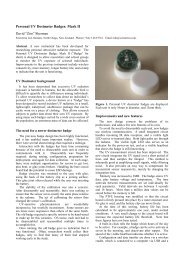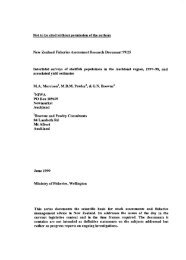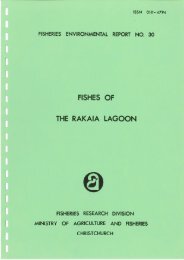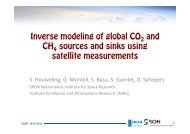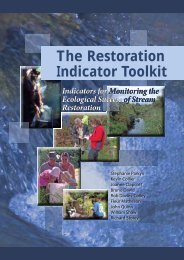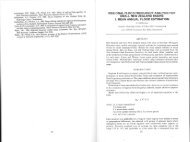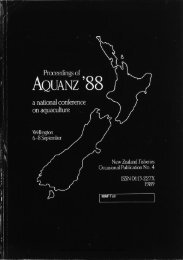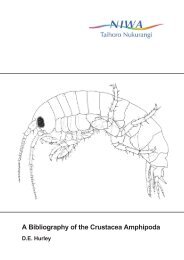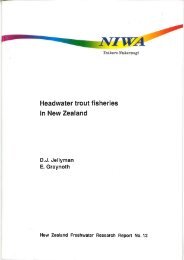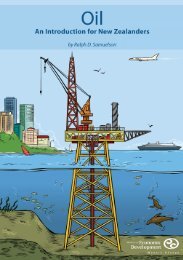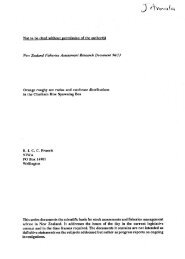WATER & SOIL - These are not the droids you are looking for.
WATER & SOIL - These are not the droids you are looking for.
WATER & SOIL - These are not the droids you are looking for.
Create successful ePaper yourself
Turn your PDF publications into a flip-book with our unique Google optimized e-Paper software.
In <strong>the</strong> first test <strong>the</strong> GEV method was often affected in<br />
this manner, producing many curves that fitted <strong>the</strong> data<br />
very well but giving 100-year flood peak estimates that were<br />
<strong>not</strong> always sensible. For example, <strong>the</strong> trend in <strong>the</strong> lower<br />
half of <strong>the</strong> series would cause <strong>the</strong> GEV curve to flatten off<br />
at <strong>the</strong> top end, impþing that <strong>the</strong>re was a limit to flood<br />
peaks of about twice <strong>the</strong> mean annual flood. While <strong>the</strong>re<br />
may be an upper limit to flood magnitude, it is certainly<br />
more than <strong>the</strong> figure implied (see Tables 3.3 and 3.6).<br />
In comparison, <strong>the</strong> straight-line fits of <strong>the</strong> Gumbel and<br />
EVI methods were often a good approximation to <strong>the</strong> data<br />
and gave more sensible 100-year flood peak estimates.<br />
However, this better per<strong>for</strong>mance by <strong>the</strong> t$'o-pa¡ameter<br />
methods can be attributed to <strong>the</strong> small samples used<br />
(NERC 1975; pp. 159-60). The fact that <strong>the</strong> Gumbel<br />
method still per<strong>for</strong>med better than <strong>the</strong> GEV method in <strong>the</strong><br />
second test suggests that <strong>the</strong> samples in this test may also<br />
have been small. However, it is also likely that <strong>the</strong> leastsquÍues<br />
fitting technique of <strong>the</strong> Gumbel method influenced<br />
<strong>the</strong> evaluation test in <strong>the</strong> method's favour.<br />
The two-parameter log-Normal method also gave good<br />
approximations to <strong>the</strong> data at times, producing a reasonable<br />
proportion of good fits. However, <strong>the</strong> method assumes<br />
that <strong>the</strong>re is no skew in <strong>the</strong> logarithms of <strong>the</strong> series, an<br />
assumption which was r<strong>are</strong>ly true. Hence <strong>the</strong> method did<br />
<strong>not</strong> per<strong>for</strong>m as well as o<strong>the</strong>rs in <strong>the</strong> test, including its p<strong>are</strong>nt<br />
method, <strong>the</strong> three-parameter LP3.<br />
A.4.5 Gonclusions<br />
The evaluations in <strong>the</strong> two tests involved a good deal of<br />
subjective judgement, but this typifies <strong>the</strong> present situation,<br />
with <strong>the</strong> objective goodness-of-fit indices <strong>not</strong> providing rigorous<br />
enough criteria <strong>for</strong> discriminating between different<br />
frequency analysis methods.<br />
From <strong>the</strong> findings of <strong>the</strong> tests, <strong>the</strong> following conclusions<br />
were reached:<br />
(¡) <strong>the</strong> Jenkinson method was <strong>the</strong> superior method in both<br />
tests and should be used in flood frequency analysis,<br />
especially when <strong>the</strong> sample is small;<br />
(iÐ <strong>the</strong> Gumbel method improved in per<strong>for</strong>mance with increase<br />
in sample size, and should be a satisfactory alternative<br />
to <strong>the</strong> Jenkinson method on <strong>the</strong> larger sam-<br />
Ples;<br />
(ii¡) <strong>the</strong> GEV and LP3 methods were more flexible than <strong>the</strong><br />
two-parameter methods, with <strong>the</strong>ir frequency curves<br />
geneially following <strong>the</strong> trend in <strong>the</strong> data extremeiy<br />
well;<br />
(iv) on small samples, in particular, <strong>the</strong> straight-line fits<br />
from <strong>the</strong> two-parameter methods can give good approximations<br />
to <strong>the</strong> data and sometimes more sensible<br />
results than those obtained from <strong>the</strong>ir p<strong>are</strong>nt threeparameter<br />
methods;<br />
(v) on small samples <strong>the</strong> LP3 method appears to per<strong>for</strong>m<br />
better than <strong>the</strong> GEV method, being influenced less by<br />
<strong>the</strong> trend in <strong>the</strong> lower part of a series;<br />
(vi) on larger samples <strong>the</strong> GEV and LP3 methods can produce<br />
similar shaped curves and give a comparable per<strong>for</strong>mance.<br />
<strong>These</strong> conclusions apply <strong>for</strong> individual records and up to<br />
References<br />
Beard, L.R. 1974: Flood flow frequency techniques. Center<br />
tor Research in Water Rnources, Univercity of<br />
Texas, Austin, Technicøl Report CRVR-|19.<br />
1977: Guidelines <strong>for</strong> determining flood flow frequency.<br />
U.S. Water Resounaes Council, Bulletin No.<br />
I7A of <strong>the</strong> Hydrologlt Committee.<br />
Beard, L.R.; Frederick, A.J. 1975: Hydrologic frequency<br />
analysis. .In Hydrologic Engineering Methods <strong>for</strong><br />
Water Resources Development Vol. 3. The Hydrologic<br />
Engineering Center, U.S. Army Corps of Engineers,<br />
Davis, Cali<strong>for</strong>nia.<br />
Benson, M.A. 1968: Uni<strong>for</strong>m flood-frequency estimating<br />
methods <strong>for</strong> federal agencies. Water Resources Reæørch<br />
4(5):891-908.<br />
Bobée, B.B. Robitaille, R. 195: Correction of bias in <strong>the</strong><br />
estimation of <strong>the</strong> co-efficient of skewness. Wøter Resources<br />
Research I I (6): 841-4.<br />
1977: The use of <strong>the</strong> Pea¡son type 3 and Log-<br />
Pearson type 3 distributions revisited. lfoter Resoutces<br />
Research I 3(2): 427 -41.<br />
Chernoff, H.; Lieberman, G.J. 1954: Use of normal probability<br />
paper. Journøl of <strong>the</strong> Americøn Stotisticol<br />
Associotion 49: 778-85.<br />
1956: The use ofgeneralised probability paper <strong>for</strong><br />
continuous distributions. Annals of Ma<strong>the</strong>moticol<br />
Statistics 27:806-18.<br />
Chow. V.T. l95l: A general <strong>for</strong>mula <strong>for</strong> hydrologic frequency<br />
analysis. Tronsactions of <strong>the</strong> Americøn Geophysicol<br />
Union 32(2): 231-7.<br />
Foster, H.A. l9A: Theoretical frequency curves and <strong>the</strong>ir<br />
applications to engineering. Tronsactiotts of <strong>the</strong><br />
American Society ol Civil Engineen 872 142-73.<br />
Gumbel, E.J. l94l: The return period of flood flows. ánnols<br />
of Ma<strong>the</strong>motical Stotistics 12: 163-X).<br />
1954: Statistical <strong>the</strong>ory of extreme values and<br />
some practical applications. US Bureou of Slondards,<br />
Applied Ma<strong>the</strong>motics Series 33l. 15-16.<br />
l!Xó: Extreme value analysis of hydrologic data.<br />
In Statistical Methods of Hydrology. Proceedings of<br />
Hydrology Symposium No. 5, McGill University,<br />
Canada, Z,-25Februw. pp. 147-69.<br />
Harter, H.L. 1969: A new table of percentage points of <strong>the</strong><br />
Pearson Type III distribution. Technometrics Il(l):<br />
177-81.<br />
Hazen, A. l9l4: Storage to be provided in impounding reservoirs<br />
<strong>for</strong> municipal water supply. Transøctions of<br />
<strong>the</strong> American Society of Civil Engineers 78:<br />
1539-641.<br />
Irish, J.; Ashkanasy, N.M. 1977: Flood frequency analysis.<br />
I¿ Australian Rainfall and Runoff. Chapter 9' The<br />
Institution of Engineers, Australia.<br />
Jenkinson, A.F. 1955: The frequency distribution of <strong>the</strong><br />
annual maximum (or minimum) values of meteoro-.<br />
logical elements. Quorterly Journal of Royal Meteo'<br />
rological Society 87: 158-71.<br />
Statistics of extremes. Iz Estimation of<br />
Maximum Floods. Chapter 5. VMO Technicql Nole<br />
No.98. pp.193-227.<br />
-1969:<br />
Kite, G.W. 1976: Frequency and risk analyses in hydrology.<br />
Inland Waters Directorate, Water Resources Branch,<br />
Dept. of E<br />
Kopittke, R.A.;<br />
e, K.S. 1976: Fre"<br />
quency an<br />
in Queensland. Ia<br />
tion of Enginæn,<br />
Hydrology<br />
Austroliq, Notionsl Co4ference Publication' No.<br />
76/2. pp.2È4.<br />
Linsley, R.K.; Kohler, M.A.; Paulhus, L.H. 195: Hydrology<br />
<strong>for</strong> Engineers. McGraw-Hill, New York.<br />
Water & soil technical publication no. 20 (1982)<br />
9l



